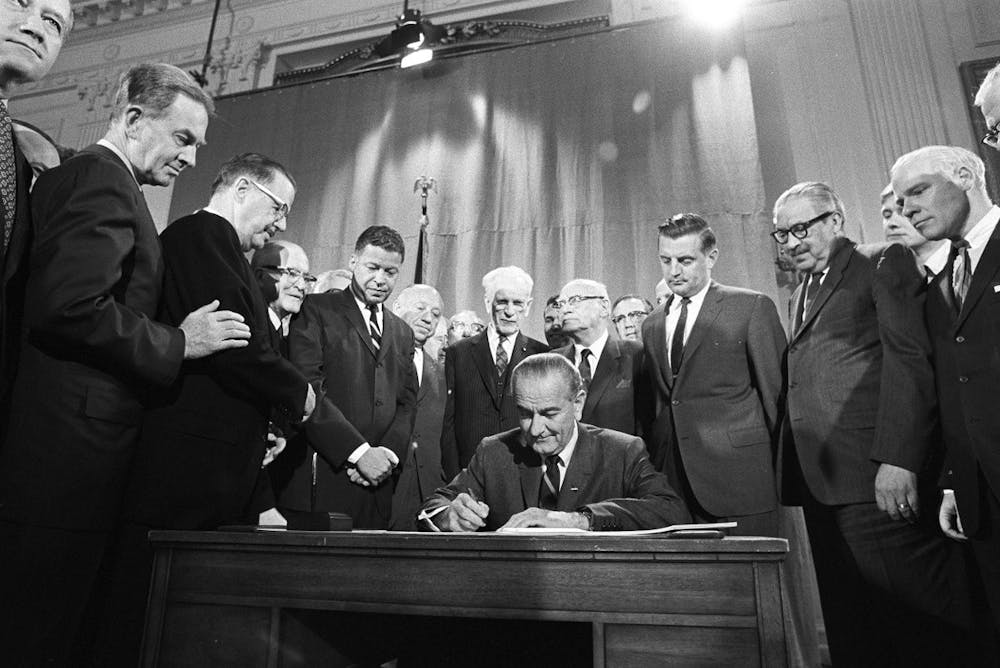Photo Caption: The Fair Housing Act was signed into law in 1968.
Photo Caption 2: Carol Sisson is the associate professor of education.
According to Oxford Languages, redlining is the refusal of a loan because someone lives in an area deemed a financial risk. Redlining negatively affects the quality of American life. A shift in school curriculum is one way to stop the effects of redlining.
“We cannot just stay oblivious,” Carol Sisson, Associate Professor of Education at Taylor University, said about the topic of redlining. Redlining was a practice that actively fueled segregation through home insurance.
Redlining was deemed illegal in 1968 by the Fair Housing Act. The trickle-down of redlining is evident in America today, and combating these effects is vital.
This topic is not covered in schools because it favors white people, putting people of color at a disadvantage.
To combat these effects, redlining must be thoroughly covered in schools. Currently, the topic is breezed over.
“I remember being taught what it was vaguely as a topic, I was a sophomore in high school,” freshman Ariana Layton said. “I hadn’t heard of the practice before my sophomore year.”
To Layton, there is still a lack of clarity around the topic.
If the effects of redlining aren’t clear from elementary school, it leaves little room to rectify the issue. Shane Wiegand, a fourth-grade teacher from Rochester, New York, outlines the standard fourth-grade history curriculum in an article titled “Teaching Redlining in Schools.” Within the content, redlining is mentioned once.
Sisson was asked if her own children were taught about redlining in school.
“They might have been taught, but it certainly was not a topic they came home and talked about learning. It probably was not taught in a super relevant way.”
Sisson later echoes this sentiment about how relevant the issue is made in curriculum. “Redlining is listed as one of a thousand facts in middle school curriculum, and its effects are never fully explained.” This must change.
“I first heard the term ‘redlining’ as a senior in high school,” freshman Thiago Camacho said. “And I didn’t even learn about the topic through school, I learned about it through my own research and through social media, the topic has to be taught in schools, otherwise the effects of redlining will continue to perpetuate, the cycle will continue.”
“The time has come to educate children about systemic racism, white privilege, implicit bias, and teach them how to be actively anti-racist citizens,” Shelby Stevens writes. “Children of color should not be forced into an education system that was set up to favor white children. Public schools must start implementing the anti-racist curriculum.”
Sisson learned more about redlining after coming to Taylor. She made it her mission to educate her students in the same way.
“I can tell when I verbally teach about the topic of redlining to my college-aged students, it goes in one ear and out the other,” Sisson said.
To change this cycle, every year, she and her students travel to Chicago as a part of a core class for the education program. During the trip, she strives to make the topic of redlining stick through ‘hands-on’ experiences.
She takes her students from one side of the street to another to show the difference redlining still makes in the quality of life for some people.
“We can't understand current justice issues if we don't understand past injustices,” Sisson said.
By making learning about redlining tangible, she hopes to better educate her students where their elementary and middle school curriculum hasn’t.
In educating this way, combatting the effects of redlining is easier.
“By mandating public schools to reform and teach anti-racist curriculum, we can move closer to a place where all students have equal opportunitie,” Stevens wrote. “We can remove the discrimination and hate from education to finally make public schools productive for everyone.”




